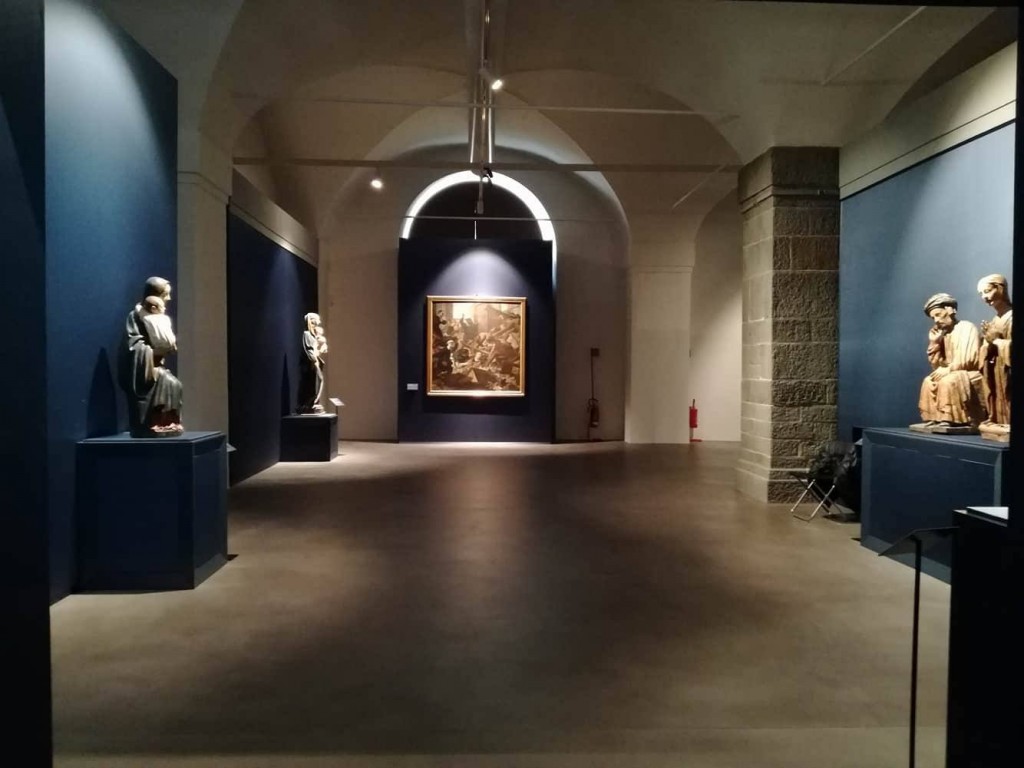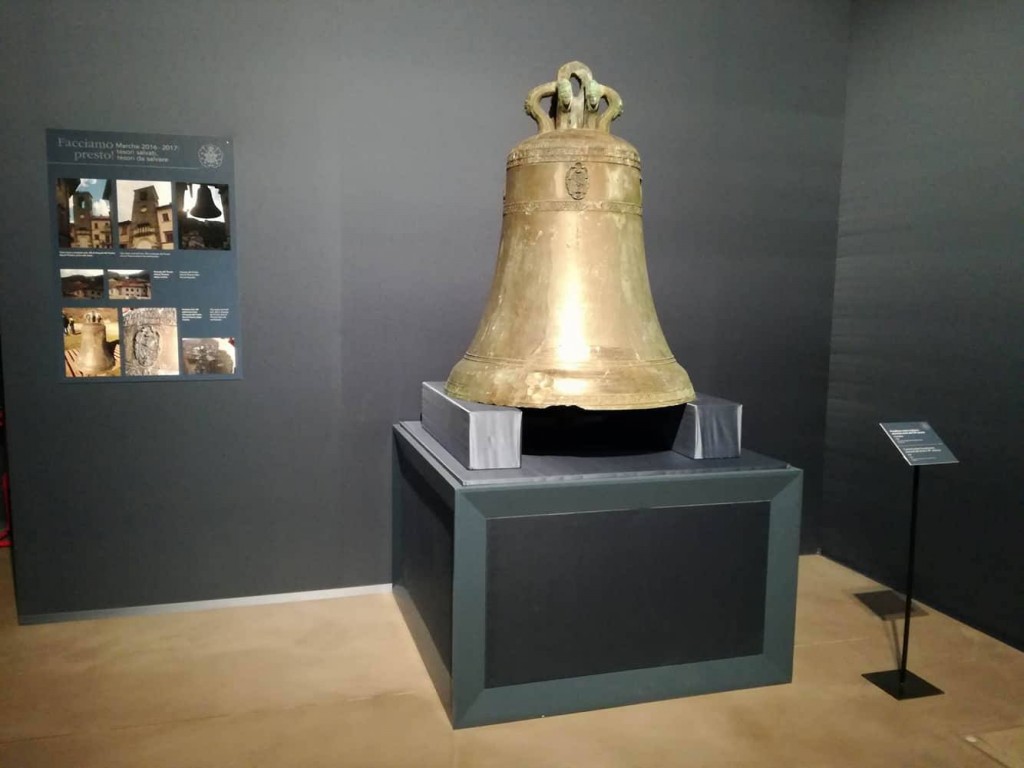
Galleria degli Uffizi, Aula Magliabechiana
28 marzo – 30 luglio 2017
Di Caterina Zaru (Università degli Studi di Firenze)
Il 28 marzo scorso la Galleria degli Uffizi ha aperto al pubblico la mostra “Facciamo presto! Marche 2016 – 2017: tesori salvati, tesori da salvare”: mostra che presenta una selezione di capolavori, oggetti d’arte e documenti provenienti dalle zone del centro Italia, colpite dal terremoto del 2016, e i cui proventi verranno utilizzati per la ricostruzione di quei monumenti colpiti dal sisma e che custodivano le opere oggi esposte agli Uffizi.
Ciò che balza subito all’occhio del visitatore di questa mostra, anche se solo da una ristretta selezione di capolavori, è la straordinaria ricchezza del patrimonio culturale delle Marche e dell’Umbria: dalla pittura su tavola e su tela alla scultura lignea, dai manufatti tessuti all’oreficeria.
Lungo il percorso espositivo, quindi, è possibile ripercorrere sinteticamente le principali tappe della storia dell’arte di questi territori, dal Medioevo al XVIII secolo. Una ricostruzione in chiave storica e cronologica delle arti umbro-marchigiane, che ha come intento principale quello di mostrare quanto urgente e importante sia salvare dalla distruzione e/o dispersione questo prezioso patrimonio.
Essendo stati distrutti i luoghi di origine o quelli che custodivano questi capolavori, si è deciso di metterli in mostra in una città, Firenze, e in un museo, gli Uffizi, che ne garantiscono una vasta visibilità e fruizione da parte dei visitatori. L’Aula Magliabechiana, che ospita l’esposizione, ne diventa una suggestiva cornice: con i suoi ampi spazi, ha lasciato la possibilità ai curatori di esporre con chiarezza e dando il giusto risalto alle opere di più piccole dimensioni, come i pezzi di oreficeria ed il manoscritto autografo dell’Infinito di Giacomo Leopardi, ma anche a quelle più imponenti, come: la Madonna in trono tra i Santi Francesco e Caterina d’Alessandria di Marco Palmezzano del 1501, proveniente dalla Chiesa di San Francesco a Matelica (Macerata); l’Assunzione della Vergine con i Santi Francesco e Chiara di Andrea Boscoli del 1605, dalla chiesa di San Francesco a San Ginesio (Macerata); l’Apparizione della Madonna col Bambino a San Filippo Neri di Giovan Battista Tiepolo, datata 1739-40 e proveniente dalla chiesa di San Filippo Neri a Camerino (Macerata).
Il tutto risulta molto ben curato e d’impatto, anche a quei visitatori che poco o nulla conoscono dell’arte umbro-marchigiana o della poetica di Leopardi. E l’allestimento è ben supportato da un utile apparato didascalico. In particolare, suggestivi risultano essere i pannelli apposti a fianco di alcune opere e in cui si riportano le fotografie dei luoghi distrutti. Chiari, anche ai meno esperti in materia, il pannello che introduce alla visita e definisce gli intenti della mostra, ma soprattutto quello che accompagna le teche dove sono ospitati i manoscritti leopardiani. Esso dà poche, essenziali informazioni sulla figura dello scrittore italiano, e spiega le motivazioni culturali che rendono unico il Museo dei Manoscritti Leopardiani di Visso.
Ma i veri protagonisti della mostra risultano essere le tre campane recuperate dal crollo dei loro campanili (Chiesa del Castello di Carpignano, Chiesa di San Francesco ad Arquata del Tronto e della Torre Civica della stessa cittadina). Le campane che, per secoli, hanno scandito il ritmo di vita, le giornate di tutta la popolazione italiana, si fanno simbolo proprio di quel patrimonio di storia e cultura che ci identifica e che, tutti noi, siamo chiamati a salvaguardare e, in questo caso, salvare.

Translation by Rachyl Grussing (Istituto Lorenzo de’ Medici)
On March 28, the Uffizi Gallery opened a new temporary exhibition, ‘Let’s do it soon! Brands: 2016 – 2017: Treasures saved, treasures to be saved’: an exhibition that presents a selection of works, objects of art, and documents all coming from the center of Italy, the area affected by the earthquake of 2016, and the proceeds of which will be used for the reconstruction of those monuments affected by the earthquake, and who keep the works today exhibited at the Uffizi.
What immediately comes to the eye of the visitor of the exhibition, even if there is only a limited selection of masterpieces, is the extraordinary richness of the cultural patrimony of Marche and Umbria: from paintings on wood and canvas to wooden sculptures, from textile artifacts to gold.
Along the course of the exhibition, then, it is possible to recreate synthetically the principle tapestry of the history of art from these territories, from medieval times to the 18th century. It is a key historical and chronological reconstruction of the arts of Umbria-Marche, whose main purpose is to show how urgent and important it is to save this precious heritage from destruction and/or dispersion.
The places of origin, or the guardians of the works, having been destroyed, it was decided to put them on display in a city, Florence, and in a museum, the Uffizi, which guaranteed visibility and enjoyment on the part of the visitor. The Magliabechiana Hall, which hosts the exhibition, becomes an evocative frame: with its ample space it has allowed the possibility for the curators to exhibit clearly and fairly the smaller works, such as jewelry pieces or the autographed manuscript of the Infinite by Giacomo Leopard, as well as the most impressive works, such as the Madonna Enthroned between St. Francis and Catherine of Alexandria by Marco Palmezzano of 1501, originating from the Church of Saint Francis in Matelica (Macerata), the Assumption of the Virgin with Saint Francis and Chiara by Andrea Boscoli of 1605, from the Church of Saint Francis in San Ginesio (Macerata), and the Appearance of Our Lady and Child at San Filippo Neri by Giovan Battista Tiepolo, dated 1739-40, and originating from the Church of San Filippo Neri in Camerino (Macerata).
Everything is well looked after, and impacts even those visitors who know little or nothing about Umbrian-Marche art or Leopardi poetry. The set-up is well supported by useful didactic apparti. In particular, the striking panels beside some of the works which display the original destroyed locations. Clear, even to the less experienced in the subject, are the panels introducing the purpose of the visit and the intent behind the show, but especially the ones that accompany the cases where the Leopardi manuscripts are held. It gives a few, essential informations on the figure of the Italian writer, and explains the cultural motivations that make the Museum of the Leopard Manuscripts unique.
But the true protagonists of the show are the three bells rescued from the collapse of their towers (Church of the Castle of Carpignano, Church of Saint Francis in Arquata del Tronto, and the Civic Tower of the same town). The bells that, for centuries, have marked the pace of life, the days of the entire Italian population, are a symbol of that heritage of history and culture that identifies us, and that we are all called to safeguard, and in this case, to save.